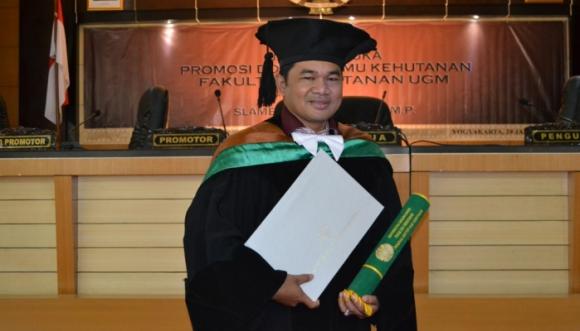
YOGYAKARTA – Orangutan is the only type of great ape in the Asian Continent. Its habitat is only in Sumatra and Kalimantan. While other types of great apes, gorillas, chimpanzees and bonobos are only found in Africa. However, Orangutans are now classified as an endangered species. The reason, the rate of degradation of forests that are converted into plantation land and settlements. “Loss of habitat, degradation and fragmentation are threats to the lives of orangutans in Sumatra and Kalimantan,” Slamet Rifanjani said in an open doctoral examination at the UGM Faculty of Forestry, Thursday (1/29).
Research on orangutan habitat in Gunung Palung National Park (TNGP), Ketapang, West Kalimantan shows a decline in Orangutan population density. This forestry lecturer at Tanjungpura University revealed that the decline in orangutan population in the national park was due to a decrease in tree density due to logging in both continuous and fragmented habitat. Decrease in tree density affects the availability of feed such as the tamarind tree (Tetramerista glabra) is a tree that has commercial value so that it is targeted for logging.
In fragmented locations the population decline was much greater at 98.08%. Data shows from 2.60 orangutans per square kilometer to 0.05 orangutans per square kilometer. Even though research conducted in 2001 showed 4 orangutans per square kilometer. This is due to the problem of reduced feed trees and fragmented locations also experience pressure due to human activities entering the orangutan habitat with high intensity.
As a result, orangutans choose to settle in trees that are relatively large and tall than the surrounding trees. The trees are generally of large diameter as nest sites which are usually located in degraded and fragmented forests. “The average orangutan’s nest is 10-20 cm in diameter and the height is between 7 and 18.5 meters,” he said.
Of the total area of the national park which reaches 90 thousand hectares, habitat space with a very suitable category in the intact area is 80,661 hectares, while the degraded and fragmented areas are 699 hectares and 1.6 hectares respectively.
Seeing this condition, Slamet recommends that the management of the National Park and the local government immediately determine a forest area that is specifically intended for orangutan habitat. “The habitat needs to be enriched with nests, feed is propagated, human access is also restricted,” he concluded. (UGM Public Relations / Gusti Grehenson)
